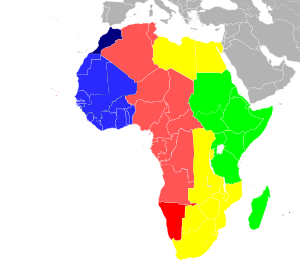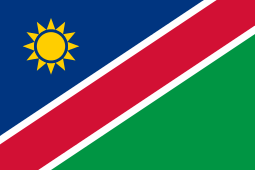Daylight saving time in Africa

Light colors indicate where standard time is observed all year; dark colors indicate where daylight savings is observed.
Note: The islands of Cape Verde are to the west of the African mainland.
The only African countries and regions that use daylight saving time are:
- Canary Islands, Ceuta and Melilla (
 Spain) – From the last Sunday in March to the last Sunday in October.[1]
Spain) – From the last Sunday in March to the last Sunday in October.[1] - Madeira (
 Portugal) – From the last Sunday in March to the last Sunday in October.[2]
Portugal) – From the last Sunday in March to the last Sunday in October.[2]  Libya - Currently year-round with no change in the winter.
Libya - Currently year-round with no change in the winter.  Morocco – From the last Sunday in March to the last Sunday in October, except the month of Ramadan.
Morocco – From the last Sunday in March to the last Sunday in October, except the month of Ramadan. Namibia – From the first Sunday in September to the first Sunday in April.
Namibia – From the first Sunday in September to the first Sunday in April.
Egypt
The British first instituted daylight saving time in Egypt during the Second World War, specifically between 1940 and 1945. The practice was stopped after the war, but resumed 12 years later, in 1957.
Egypt normally observed daylight saving time between the last Friday in April and the last Thursday in September when the clocks were three hours ahead of Greenwich Mean Time (UTC+3). The change occurred one second after 23:59:59 on Thursday to become 1:00:00 on the last Friday in April shortening the day to 23 hours. Summer time ended one second after 23:59:59 to become 23:00:00 on the last Thursday of September lengthening the day to 25 hours. The date did not change one second after the first 23:59:59 occurred; for all practical purposes, midnight did not occur until after the second 23:59:59. An exception was made for Ramadan; in 2006 the end of DST took place one week earlier, on September 21, 2006, which took place before the start of the holy month of Ramadan. The same practice recurred in 2007 and 2008, to avoid having longer days in Ramadan. In 2009, summer time ended on Thursday, August 20, five weeks before the nominal end on the last Thursday in September. In 2010, the summer time started on April 30, and ended on September 30, but between August 10 and September 10, summer time was cancelled because of Ramadan. The previous government was planning to take a decision to abolish it in 2011 before the January 25 Revolution. The transitional government abolished daylight saving time on April 20, 2011.[3] On May 7, 2014, the Egyptian government restored daylight saving time starting on May 16, 2014 with an exception for the holy month of Ramadan.[4]
From 2015 onwards, Egypt no longer observes it.[5] On April 29, 2016, the Egyptian government made plans to restore daylight saving time starting on July 7th, 2016 during Eid al-Fitr, however later on July 4, 2016, the Egyptian government cancelled these plans to re-introduce DST.
Libya
Libya observed DST each year from 1982 to 1989,[6] 1997,[7] and 2013.[8]
Morocco
As of 2013, daylight saving time (DST) is observed in Morocco, advancing to UTC+1 at 02:00 on the last Sunday of March, and reverting to UTC (standard time) at 03:00 on the last Sunday of October, with the exception of the month of Ramadan, during which clocks revert to UTC (standard time).[9][10]
Namibia
DST begins on the first Sunday in September, and ends on the first Sunday in April.
Tunisia
Tunisia adopted daylight saving time for the first time in 2005 starting 1 May 2005 and following EU time schedules thereafter. This comes as a move by the government to promote saving of energy. In 2009 the government of Tunisia canceled DST and kept the standard time all year round.
African countries not using DST
These countries or regions do not use daylight saving time, although some have in the past:
- Algeria
- Angola
- Benin
- Botswana
- Burkina Faso
- Burundi
- Cameroon
- Cape Verde
- Central African Republic
- Chad
- Comoros
- Côte d'Ivoire
- Democratic Republic of Congo
- Djibouti
- Egypt
- Equatorial Guinea
- Eritrea
- Ethiopia
- Gabon
- Gambia
- Ghana
- Guinea
- Guinea-Bissau
- Kenya
- Lesotho
- Liberia
- Libya
- Madagascar
- Malawi
- Mali
- Mauritania
- Mauritius
- Mayotte
- Niger
- Nigeria
- Republic of the Congo
- Rwanda
- Saint Helena, Ascension and Tristan da Cunha
- São Tomé and Príncipe
- Senegal
- Sierra Leone
- Somalia
- South Africa
- South Sudan
- Sudan
- Swaziland
- Tanzania
- Togo
- Tunisia
- Uganda
- Zambia
- Zimbabwe
References
- ↑ Although these regions politically belong to Spain in Europe, they are geographically part of or lying off the coast of Africa. They have DST schedules according to EU rules.
- ↑ Although Madeira politically belongs to Portugal in Europe, it is geographically part of and lying off the coast of Africa. It has DST schedules according to EU rules.
- ↑ "Egypt to cancel daylight saving time".
- ↑ "Daylight saving to be applied in Egypt starting Friday".
- ↑ http://www.timeanddate.com/news/time/egypt-cancels-dst-2015.html
- ↑ Daylight saving time dates for Libya - Tripoli between 1980 and 1989, Time and Date.
- ↑ Daylight saving time dates for Libya - Tripoli between 1900 and 1909, Time and Date.
- ↑ Libya Changes Time Zone, Time and Date, November 10, 2012.
- ↑ "Morocco extends DST to October 27, 2013". timeanddate.com. 28 September 2013. Retrieved 1 October 2013.
- ↑ "L'horaire d'été (GMT+1) maintenu jusqu'au 27 octobre 2013" (in French). Royaume de Maroc. 28 September 2013. Retrieved October 1, 2013.